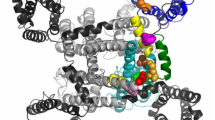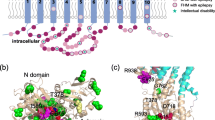Abstract
Familial hemiplegic migraine type 1 (FHM-1) is caused by mutations in CACNA1A, the gene encoding for the Cav2.1 subunit of voltage-gated calcium channels. Although various studies attempted to determine biophysical consequences of these mutations on channel activity, it remains unclear exactly how mutations can produce a FHM-1 phenotype. A lower activation threshold of mutated channels resulting in increased channel activity has been proposed. However, hyperactivity may also be caused by a reduction of the inhibitory pathway carried by G-protein-coupled-receptor activation. The aim of this study is to determine functional consequences of the FHM-1 S218L mutation on direct G-protein regulation of Cav2.1 channels. In HEK 293 cells, DAMGO activation of human μ-opioid receptors induced a 55% Ba2+ current inhibition through both wild-type and S218L mutant Cav2.1 channels. In contrast, this mutation considerably accelerates the kinetic of current deinhibition following channel activation by 1.7- to 2.3-fold depending on membrane potential values. Taken together, these data suggest that the S218L mutation does not affect G-protein association onto the channel in the closed state but promotes its dissociation from the activated channel, thereby decreasing the inhibitory G-protein pathway. Similar results were obtained with the R192Q FHM-1 mutation, although of lesser amplitude, which seems in line with the less severe associated clinical phenotype in patients. Functional consequences of FHM-1 mutations appear thus as the consequence of the alteration of both intrinsic biophysical properties and of the main inhibitory G-protein pathway of Cav2.1 channels. The present study furthers molecular insight in the physiopathology of FHM-1.





Similar content being viewed by others
Abbreviations
- DAMGO:
-
(d-Ala2,N-Me-Phe4,glycinol5)-Enkephalin
- FHM-1:
-
familial hemiplegic migraine type 1
- hMOR:
-
human μ-opioid receptor
- GI:
-
G-protein inhibition
- RI:
-
recovery from inhibition
- CSD:
-
cortical spreading depression
- NS:
-
not statistically significant
References
Bolay H, Reuter U, Dunn AK, Huang Z, Boas DA, Moskowitz MA (2002) Intrinsic brain activity triggers trigeminal meningeal afferents in a migraine model. Nat Med 8:136–142
De Waard M, Hering J, Weiss N, Feltz A (2005) How do G proteins directly control neuronal Ca2+ channel function? Trends Pharmacol Sci 26:427–436
De Waard M, Liu H, Walker D, Scott VE, Gurnett CA, Campbell KP (1997) Direct binding of G-protein bγ complex to voltage-dependent calcium channels. Nature 385:446–450
Fitzsimons RB, Wolfenden WH (1985) Migraine coma. Meningitic migraine with cerebral oedema associated with a new form of autosomal dominant cerebellar ataxia. Brain 108(Pt 3):555–577
Hans M, Luvisetto S, Williams ME, Spagnolo M, Urrutia A, Tottene A, Brust PF, Johnson EC, Harpold MM, Stauderman KA, Pietrobon D (1999) Functional consequences of mutations in the human a1A calcium channel subunit linked to familial hemiplegic migraine. J Neurosci 19:1610–1619
Headache Classification Subcommittee of the International Headache Society (2004) The international classification of headache disorders: 2nd edition. Cephalalgia 1(24):9–160
Kors EE, Terwindt GM, Vermeulen FL, Fitzsimons RB, Jardine PE, Heywood P, Love S, van den Maagdenberg AM, Haan J, Frants RR, Ferrari MD (2001) Delayed cerebral edema and fatal coma after minor head trauma: role of the CACNA1A calcium channel subunit gene and relationship with familial hemiplegic migraine. Ann Neurol 49:753–760
Kraus RL, Sinnegger MJ, Glossmann H, Hering S, Striessnig J (1998) Familial hemiplegic migraine mutations change a1A Ca2+ channel kinetics. J Biol Chem 273:5586–5590
Kraus RL, Sinnegger MJ, Koschak A, Glossmann H, Stenirri S, Carrera P, Striessnig J (2000) Three new familial hemiplegic migraine mutants affect P/Q-type Ca2+ channel kinetics. J Biol Chem 275:9239–9243
Lauritzen M (1994) Pathophysiology of the migraine aura. The spreading depression theory. Brain 117(Pt 1):199–210
Ludwig A, Flockerzi V, Hofmann F (1997) Regional expression and cellular localization of the a1 and b subunit of high voltage-activated calcium channels in rat brain. J Neurosci 17:1339–1349
Melliti K, Grabner M, Seabrook GR (2003) The familial hemiplegic migraine mutation R192Q reduces G-protein-mediated inhibition of P/Q-type (Cav2.1) calcium channels expressed in human embryonic kidney cells. J Physiol 546:337–347
Mullner C, Broos LA, van den Maagdenberg AM, Striessnig J (2004) Familial hemiplegic migraine type 1 mutations K1336E, W1684R, and V1696I alter Cav2.1 Ca2+ channel gating: evidence for b-subunit isoform-specific effects. J Biol Chem 279:51844–51850
Ophoff RA, Terwindt GM, Vergouwe MN, van Eijk R, Oefner PJ, Hoffman SM, Lamerdin JE, Mohrenweiser HW, Bulman DE, Ferrari M, Haan J, Lindhout D, van Ommen GJ, Hofker MH, Ferrari MD, Frants RR (1996) Familial hemiplegic migraine and episodic ataxia type-2 are caused by mutations in the Ca2+ channel gene CACNL1A4. Cell 87:543–552
Pietrobon D (2005) Migraine: new molecular mechanisms. Neuroscientist 11:373–386
Tedford HW, Zamponi GW (2006) Direct G protein modulation of Cav2 calcium channels. Pharmacol Rev 58:837–862
Tottene A, Fellin T, Pagnutti S, Luvisetto S, Striessnig J, Fletcher C, Pietrobon D (2002) Familial hemiplegic migraine mutations increase Ca2+ influx through single human Cav2.1 channels and decrease maximal Cav2.1 current density in neurons. Proc Natl Acad Sci USA 99:13284–13289
Tottene A, Pivotto F, Fellin T, Cesetti T, van den Maagdenberg AM, Pietrobon D (2005) Specific kinetic alterations of human Cav2.1 calcium channels produced by mutation S218L causing familial hemiplegic migraine and delayed cerebral edema and coma after minor head trauma. J Biol Chem 280:17678–17686
van de Ven RC, Kaja S, Plomp JJ, Frants RR, van den Maagdenberg AM, Ferrari MD (2007) Genetic models of migraine. Arch Neurol 64:643–646
van den Maagdenberg AM, Pietrobon D, Pizzorusso T, Kaja S, Broos LA, Cesetti T, van de Ven RC, Tottene A, van der Kaa J, Plomp JJ, Frants RR, Ferrari MD (2004) A Cacna1a knockin migraine mouse model with increased susceptibility to cortical spreading depression. Neuron 41:701–710
Weiss N, Arnoult C, Feltz A, De Waard M (2006) Contribution of the kinetics of G protein dissociation to the characteristic modifications of N-type calcium channel activity. Neurosci Res 56:332–343
Weiss N, De Waard M (2007) Introducing an alternative biophysical method to analyze direct G protein regulation of voltage-dependent calcium channels. J Neurosci Methods 160:26–36
Weiss N, Tadmouri A, Mikati M, Ronjat M, De Waard M (2007) Importance of voltage-dependent inactivation in N-type calcium channel regulation by G-proteins. Pflugers Arch 454:115–129
Acknowledgments
We warmly thank Dr. Daniela Pietrobon for helpful comments and discussion on the manuscript. We are very grateful to Dr. J. Striessnig (University of Innsbruck, Austria) for the gift of the Cav2.1R192Q cDNA. We acknowledge financial support of INSERM. Additional support was obtained from EU project EUROHEAD (LSHM-CT-2004-504837).
Author information
Authors and Affiliations
Corresponding author
Rights and permissions
About this article
Cite this article
Weiss, N., Sandoval, A., Felix, R. et al. The S218L familial hemiplegic migraine mutation promotes deinhibition of Cav2.1 calcium channels during direct G-protein regulation. Pflugers Arch - Eur J Physiol 457, 315–326 (2008). https://doi.org/10.1007/s00424-008-0541-2
Received:
Revised:
Accepted:
Published:
Issue Date:
DOI: https://doi.org/10.1007/s00424-008-0541-2




